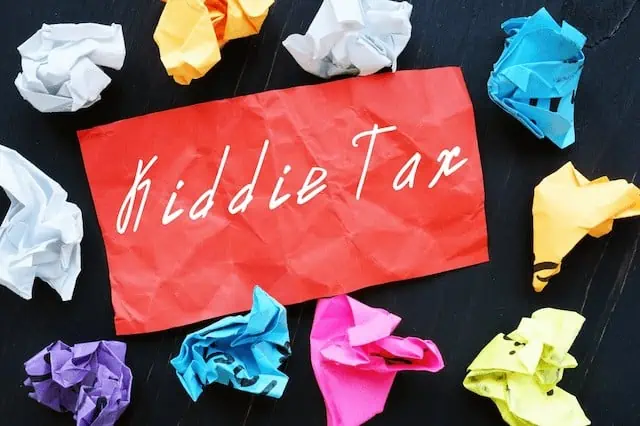“What is the best way to invest $1,000 for a child?”
This is a difficult question for many people to answer. What’s best? A savings account or college fund? The stock market or real estate? The answer depends on the person, but there are some common sense guidelines that you should follow when considering investment options for your child.
In this article, we will take a look at the best way to invest $1,000 for a child, considerations to make and examine several of the different investment opportunities available.
Table of Contents
Best Ways to Invest $1,000 for a Child’s Future—Top Picks
|
3.6
|
4.4
|
|
Personal: $3/mo. Personal Plus: $6/mo. Premium: $12/mo.
|
$1.99/contribution, $1.99/gift
|
Why You Should Invest While Young
Investing isn’t just for adults. Many often say youth is wasted on the young. In the case of investing, this isn’t the case. Compounding returns can differentiate a portfolio significantly in terms of performance. To illustrate, let’s consider two simple examples of the power of compounding.
→ Compounding Example 1:
Imagine a parent who invests $1 per day from birth until the child’s 18th birthday into a low-cost S&P 500 index fund that averages an annual return of 8.5%. The child never invests another dollar in this account from then until retirement at 68. The child would have received $6,574 in contributions before reaching 18.
After 68 years of compounding at that annual return, the child would become a millionaire on this account alone by having a total wealth of $1,068,540.
→ Compounding Example 2:
Now imagine another person who never saved a cent until their 18th birthday. From that day until retiring at 68, this person also invests $1 per day and receives the same 8.5% annual return.
This adult would have contributed $18,262 to the retirement account. In return, this retirement account balance would only amount to $293,072.
The second example didn’t do anything different beyond waiting longer to invest. This speaks to two things: first, the power of compounding. Second, the efficiency of tax-advantaged retirement accounts.
Best Investment Accounts for Kids
Kid investment accounts span a few different areas and depend on your investment objective. For example, if the goal is college savings or paying off student loans, 529 plans might work best. If you are looking for a retirement account to fund your child’s future needs, then go with an IRA.
And if you want a way to teach kids about investing and have fun doing it at the same time, you might consider a UGMA/UTMA custodial account to do that.
Best Investment Plans for a Child’s Future
1. Custodial Accounts (UTMA vs UGMA)
Custodial accounts act as a great means to provide long-term investing options for your child. These are perfect for you to teach topics on investing for kids.
You can contribute money to the account and manage it with their ability to see how you handle the investments together. A single adult can contribute up to $19,000 per year in 2025 to the custodial account while a couple can contribute up to $38,000 per year if they file taxes jointly.
Custodial accounts come in two flavors:
- UTMA (Uniform Transfer to Minors Act) – These accounts allow a custodian to invest in traditional assets like stocks, bonds, ETFs, mutual funds and related securities.
- UGMA (Uniform Gifts to Minors Act) – This type of custodial account can be used in a variety of ways, which include alternative investments. Along with their traditional uses like financial assets and investment vehicles, UGMA custodial accounts can also be used to store items such as property deeds, automobiles and valuable art collections.
A parent, guardian or other individual (the custodian) opens an account in the child’s name and contributes money irrevocably into the account. That means money placed into the account cannot be taken back. It remains the property of the minor.
The account then transfers ownership when the child reaches the age of majority in his or her state of residence.
Custodial accounts are often used as a means of investing money that you want to remain with your child until they come of age, or when they graduate from high school.
If you can only invest $1,000 at your child’s birth in a custodial account, you’ll have an ending account balance of $317,227 in retirement. That’s over 300x on your $1,000 contributed at birth under the same 8.5% average annual return scenario.
If you contribute $1,000 every year from your child’s birth until they turn 18 and let the money compound until turning 68, they’d have $3,236,705. That’s a fantastic return any kid would be grateful to receive.
Custodial Accounts With Acorns ($20 Bonus)

- Available: Sign up here
- Price: Acorns Gold: $12/mo.
Acorns offers a custodial brokerage account for parents interested in opening an investment account for their child called Acorns Early, which is available by subscribing to Acorns Premium.
Acorns Early offers investment portfolios of various risk levels for kids, so you can feel confident in the account you’re opening up for your little one. And thanks to a library of financial literacy content, this micro-investing app can be a great way to teach minors how to invest money.
The best part about Acorns is that it doesn’t require any minimum deposit to get started and allows you to contribute money on a regular basis. With Acorns Smart Deposit, you can automatically invest part of your paycheck each pay period and allocate it to Acorns Early, Invest, and Later accounts.
Learn more in our Acorns review.
- Acorns allows you to sign up for investment, retirement, and checking accounts for you and your family, learn how to earn more money, and grow your investing knowledge.
- Famous for investing spare change automatically through Round-Ups, this all-in-one financial app helps younger generations start investing earlier.
- Invest in expert-built portfolios made up of diversified ETFs.
- Silver tier includes perks such as a 25% match on Acorns Earn rewards (up to $200/mo.), generous APYs on Checking and Emergency Fund, and live Q&As with investing experts.
- Gold tier includes perks such as a 50% match on Acorns Earn rewards (up to $200/mo.), $10,000 in life insurance, picking individual stocks for your portfolio, a free Acorns Early account, and Acorns Early Invest custodial accounts for children with 1% contribution matches.
- Earn even more with Later Match: Acorns will match up to 1% (Silver) or 3% (Gold) of all new IRA contributions in your first year.*
- Special offer: Get a free $20 bonus investment when you sign up with our link and start making recurring investments.**
- Robo-advisor with affordable fees (on larger portfolios)
- Fixed fee model
- Round-ups
- FDIC/SIPC insurance
- IRA match (Silver and Gold)
- High fixed fees for small balances
- Limited investment selections
- Must subscribe to Gold for any self-directed investing options
Related: Best Trading Accounts for Minors
2. Joint Brokerage Account
The standard type of brokerage account is an individual brokerage, in which one person’s name is listed as the account owner.
A jointly owned brokerage account, however, allows two or more people to sit on the account’s title and act as owners of all assets within the account.
These accounts most commonly exist between spouses, but they can also be opened between multiple family members (say, a parent and child) or two or more individuals who share financial goals (say, unmarried partners or business partners).
When a parent and child have a jointly owned brokerage account, they can share in the decision-making of what to buy and sell. Many investing apps for kids allow you to open a brokerage account with joint ownership.
Related: Best Debit Cards for Kids
3. 529 Plans
For those lucky enough not to have noticed, college now costs a small private fortune to attend. If the trend continues unabated, you can expect the cost for your child to attend college to become even more unaffordable by the time they’re ready to pack up and move into the dorm.
Fortunately, the tax law allows for you to save for college expenses in a tax-smart way with 529 plans.
These plans allow you to save after-tax money in suitable investments which you can sell to pay for qualified educational expenses. If used for this purpose, you won’t need to pay taxes on any realized gains from the account.
They are relatively easy to establish and offer some of the great returns on your investment when compared with other ways to invest $1,000 for a child.
For example, if you invest $1,000 per year for your child in a 529 plan and receive the same 8.5% annual return as above, you can expect to make $18,000 worth of contributions and have an ending balance of $46,866.
That’s a major step toward paying for college expenses, especially if your child can earn scholarships and consider attending an in-state school.
529 plans have evolved to include more than college expenses, however. After tax reform in 2018, the plans now can be used to:
- Pay for qualified expenses relating to K-12 public, private and religious schools.
- Pay for college and other post-secondary education expenses like for professional school or graduate school
Most withdrawals count as tax-free and:
- Single parents can contribute up to $85,000 per year
- Married couples can contribute up to $170,000 per year.
529 plans technically invest in plans organized at the state level, meaning each state has its own set of rules tied to 529 plans and the investment options available.
The best 529 plans allow funds contributed from an individual, couple, or family members (up to the annual gift exclusion).
529 Plans With Backer
A great option to consider is Backer. Backer, a hassle-free 529 Savings Plan where your family and friends can play a role, has helped families save over $20 million towards college in just minutes.
You can use the 529 plan to put your child on track to afford college; all while remaining invested in an asset class that will grow over time.
You are able to invest using Backer’s portfolio of low-cost index funds including: large company stocks (S&P 500), small cap stocks (Russell 2000) international companies shares (MSCI EAFE Index), US government bonds (Barclays Aggregate Bond Index).
In sum, 529 plans offer a narrow set of uses on qualified education expenses. They can provide a means to avoid having your children take on costly student loans and offer tax incentives to do so.
For financial needs outside of schooling, you might consider opening an investment account like a UGMA/UTMA custodial account, joint brokerage account or custodial IRA.
- Backer allows you to invest your educational savings tax-free in a 529 plan and also allows for family and friends to help you to save more.
- Use low-cost index funds to invest in different asset classes, including stocks and bonds.
Related: 5 Best Under-18 Investment Accounts
4. Custodial IRAs
Retirement accounts might seem like an odd choice for a teenager to trade stocks because retirement is over 50 years away for them.
But recall the example from above and how the one child who only invested $1 a day from birth until turning 18 became a millionaire through compounding. Now, imagine investing more and then continuing to invest past becoming an adult.
The money in the account would swell over time, securing their retirement just from a few actions taken very early on in the child’s life.
But, children can’t open an investment account by themselves. They need to make use of a custodial account. You’ll serve as a custodian until your child turns 18. When they reach adulthood, the account ownership reverts to their hands.
Though, be warned, when you or others make contributions to a custodial account, these funds become irrevocable, meaning they legally belong to the minor investing in the account, both the contributions and gains.
Securing those gains from above from taxes means you’ll want to invest in a tax-advantaged account. That means they need to open an IRA.
In their case, that means needing earned income and also contributing their tax-advantaged retirement savings into a custodial IRA at that.
E*Trade (Our Top Pick for Custodial IRAs)
- Available: Click “Open Account” below
- Best for: Intermediate investors
- Platforms: Web, mobile app (Apple iOS, Android)
Most people know E*Trade as one of the leading providers of individual brokerage accounts, but you can also put the powerful platform to work saving for your child’s future.
E*Trade’s IRA for Minors offering allows you to open up a traditional custodial IRA or a custodial Roth IRA for children under age 18 who have earned income. Within the account, you can build a personalized portfolio through thousands of stocks, bonds, ETFs, and mutual funds, or you can have E*Trade select your holdings for you through its Core Portfolio robo-advisory service.
Just like with its individual brokerage accounts, E*Trade custodial IRAs offer zero-commission stock, ETF, and options trading. It also has a leg up on some platforms by offering $0-commission mutual fund, Treasury, and new-issue bond trading.
And if you want to learn more about investing—or want your young one to learn alongside you—E*Trade also boasts educational resources, including articles, videos, classes, monthly webinars, and even live events.
Read our review, or visit E*Trade and sign up by clicking “Open Account” below to see if it’s the right fit for you.
- E*Trade is one of the best online and mobile trading platforms among discount brokers, offering a full range of investments.
- E*Trade's IRA for Minors allows children under 18, who have earned income, to start saving for their retirement.
- The platform's custodial IRA allows you to build your own portfolio of stocks, ETFs, mutual funds, bonds, and more, or it can build one for you through its Core Portfolios service.
- $0 commission trading for online U.S.-listed stocks, ETFs, options, mutual funds, Treasuries, and new-issue bonds.
- Opening an account is easy and only takes a couple of minutes.
- Excellent selection of available investments
- Commission-free trading on stocks, ETFs, mutual funds, and Treasuries
- Automated portfolio builders and prebuilt mutual fund and ETF portfolios
- Limited availability of fractional shares (only in DRIP plans or robo-created portfolio)
Related: Best Investments to Buy for Kids
Traditional vs. Roth

Custodial IRAs come in two flavors: Traditional vs. Roth.
Every individual with earned income can contribute to an individual retirement account, or IRA. These accounts come in multiple flavors depending on your needs, but most commonly as standard Traditional and Roth IRA types. These two accounts essentially mirror each other with how they handle taxes.
- Traditional IRAs allow you to deduct your contributions from your taxable income in the year of contribution. This defers taxes until you withdraw them in retirement.
For example, if you have a taxable income of $50,000 and contribute $1,000 to your traditional IRA, you’ll only have a taxable income of $49,000. This means you pay taxes at the 22% rate and you’ll pay $220 less in taxes that year, all else equal.
- Roth IRAs differ because they don’t offer any upfront deduction for contributions like a traditional IRA does. Instead, you contribute after-tax money into a Roth IRA and can withdraw it tax-free in retirement.
You would contribute to a Traditional IRA if you think your income tax rate will decline in retirement compared to now. Conversely, if you think you will have more income in retirement than you do now, you will want to contribute to a Roth IRA.
Kids who have earned income likely want to contribute to a Roth IRA because they only stand to earn more money after finishing school and working full-time. Further, they probably don’t need to lower their taxable income to fall into a lower tax bracket now like they would with a Traditional IRA later.
Therefore, opening a custodial Roth IRA for a child who earns income makes the most sense. A custodial Roth IRA allows your child to make tax-free withdrawals on their account’s earnings when they retire.
One important rule to know about Roth IRAs, however, is that you may encounter a 10% penalty for making an early withdrawal. Certain use cases allow you to withdraw contributions the account owner has made into the account like buying a first-home. The trick will become convincing your child to leave the money in the account once they legally gain access upon turning 18. This way, they reap compounding returns while also avoiding a nasty penalty.
What is the Kiddie Tax Rule?

One area you’ll need to be aware of for custodial accounts is the kiddie tax rule. People took advantage of the loophole from gifting shares of stocks to their kids and the government caught notice.
The federal government passed the kiddie tax, preventing people from abusing this loophole. This tax requires parents to pay the marginal income tax rate on all unearned income realized in the account. This rule applies to all investment income for kids under 19 or full-time students under 23.
This doesn’t make the child pay higher taxes than their current wages. The IRS allows the first $1,250 of unearned income to be tax-free ($1,300 in 2024), the second $1,250 to be taxed at the child’s rate and then any balance above that at the parents’ rate ($1,300 in 2024). This means that if you put $1,000 into an account each year for your teenager and they earn under $1,250 ($1,300) in dividends, it’s tax free. However, if it’s $1,700, there will be taxes due on $400 of that amount.
If the account has $2,800 in dividends, $1,250 ($1,300) will be untaxed, $1,250 ($1,300) will be at the child’s tax rate and $300 ($200) at the parents’ rate. If your child takes this income out of the account, this could be a good way to teach teenage money management.
Related:
- 31 Passive Income Ideas [Income Investments to Consider]
- 15 High-Yield Investment Options [Best Investments Right Now]
What is Micro-Investing?
A powerful tool to get your kid to start investing early is something called micro-investing. Micro-investing is a method that allows you to invest small sums of money, which can be as little as $0.25 per day. A micro-investing platform is a type of investing where the individual invests in stocks or other assets on an ongoing basis over time, with each investment being very small and thus low-risk because it will take years to grow in value.
However, by regularly contributing money over time, these wealth building habits can quickly lead to turning money into more money and growing account balances. Remember the example above about investing $1 per day every day? That small, steady progress reaps huge gains over long enough periods of time.
What are the Best Ways to Invest $1,000 for a Child?
One of the best ways to invest $1,000 for a child includes buying stocks through joint brokerage accounts and custodial accounts. The best ones include the following stock investing apps for beginners.
1. Greenlight App

- Available: Sign up here
- Price: Greenlight Max: $9.98/mo.
Greenlight Max is an investment account for kids that comes paired with a debit card for teens.
It’s easy to use and can double as a savings account and banking app for teens. The app will teach the basics of investing, how to invest money in stocks and ETFs, etc.
It works best if parents and/or grandparents are involved in the process because it requires linked accounts from the custodians’ banks or brokerages.
The all-in-one plan teaches them important financial skills like money management and investing fundamentals — with real money, real stocks and real-life lessons.
You can use the investing feature to:
- Buy fractional shares of companies your kids admire (kid-friendly stocks)
- Start investing with as little as $1 in your account (with fractional shares)
- No trading commissions beyond the monthly subscription fee
- Parents approve every trade directly in the app on individual stocks and ETFs with a market capitalization of $1 billion+
Consider opening a Greenlight Max or Infinity account to start investing in a custodial brokerage account for your kids today, or read more in our Greenlight Card review.
- Greenlight is a financial solution for kids that allows them to spend with a debit card, earn money on savings, and even invest their money.
- Parents can use this app to teach kids how to invest with a brokerage account through Greenlight Max and Greenlight Infinity plans.
- Greenlight offers flexible parental controls for each child and real-time notifications of each transaction. And it's the only debit card that lets you choose the exact stores where kids can spend on the card.
- Families can earn 2% (Core), 3% (Max) or 5% (Infinity) per annum on their average daily savings balance of up to $5,000 per family. Also, Max and Infinity families can earn 1% cash back on their monthly expenditures.
- Unlike many apps that simply provide features and controls, Greenlight is also designed to spark discussions with children about spending, investing, and more, fostering a better educational experience.
- Best-in-class parental controls (can prohibit specific stores)
- Can add brokerage account to invest in stocks
- Intuitive Parent and Kid apps
- Competitive cash back and interest rates
- High price points
- No cash reload options
- No parent / child lending
Related: 9 Best Fractional Share Brokerages to Buy Partial Stocks & ETFs
2. Acorns Early ($20 Bonus)
- Acorns allows you to sign up for investment, retirement, and checking accounts for you and your family, learn how to earn more money, and grow your investing knowledge.
- Famous for investing spare change automatically through Round-Ups, this all-in-one financial app helps younger generations start investing earlier.
- Invest in expert-built portfolios made up of diversified ETFs.
- Silver tier includes perks such as a 25% match on Acorns Earn rewards (up to $200/mo.), generous APYs on Checking and Emergency Fund, and live Q&As with investing experts.
- Gold tier includes perks such as a 50% match on Acorns Earn rewards (up to $200/mo.), $10,000 in life insurance, picking individual stocks for your portfolio, a free Acorns Early account, and Acorns Early Invest custodial accounts for children with 1% contribution matches.
- Earn even more with Later Match: Acorns will match up to 1% (Silver) or 3% (Gold) of all new IRA contributions in your first year.*
- Special offer: Get a free $20 bonus investment when you sign up with our link and start making recurring investments.**
- Robo-advisor with affordable fees (on larger portfolios)
- Fixed fee model
- Round-ups
- FDIC/SIPC insurance
- IRA match (Silver and Gold)
- High fixed fees for small balances
- Limited investment selections
- Must subscribe to Gold for any self-directed investing options
How Do I Talk About Investing With My Kids?
Broaching the subject of investing can be a tricky topic with kids, especially when they have so many competing priorities in their lives. But that’s nothing to worry about because having patience and showing them the importance of investing as a long-term endeavor go hand-in-hand.
Start by talking about investing regularly and like it’s a normal part of life. Demystify the topic and make sure it does happen as a one-off conversation. Continue to nurture their interest in the area by talking about stocks, the market or economic events at least weekly.
By making it a recurring subject of discussion, your kids will eventually take the bait and ask questions. If nothing else, they know by showing genuine interest in learning what you’re talking about, it’ll get you to quit mentioning it all the time!
Most kids want to engage and understand more about what you say. Therefore, emphasizing it regularly will lead to more fruitful conversations. From there, you can talk about companies and the importance of investing in good ones you think will succeed.
To give you ideas about good companies to follow, consider subscribing to or using:
- stock newsletters
- stock picking services
- stock advisory services
- stock tracking apps
- stock news apps
- stock analysis apps
These will all be good places for them to start and learn about exciting companies making the news. You might also break down their favorite companies through focusing on the best stocks for kids. Avoid using jargon where possible and instead speak to them with direct language they can understand.
By painting a full picture for them, you kids might have an easier time engaging in the conversation and following your overarching ideas. With enough time, repetition and excitement, you can start to lure your children into the world of investing with ease and interest.

















![6 Best Money Market Funds [Protect Your Savings, 2026] 48 a businessman protects his savings in the safe.](https://youngandtheinvested.com/wp-content/uploads/money-market-funds-safe-safety-security-1200-600x403.webp)


